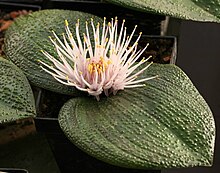Massonia
| Massonia | |
|---|---|

| |
| Massonia pustulata in cultivation | |
| Scientific classification | |
| Kingdom: | Plantae |
| Clade: | Tracheophytes |
| Clade: | Angiosperms |
| Clade: | Monocots |
| Order: | Asparagales |
| Family: | Asparagaceae |
| Subfamily: | Scilloideae |
| Genus: | Massonia Thunb. ex Houtt.[1] |
| Type species | |
| Massonia depressa | |
| Synonyms[1] | |
| |
Massonia is a
The genus is named for
Description
Massonia grows from underground bulbs whose outer tunic is pale brown and papery or leathery. Two relatively broad leaves appear at the same time as the flowers, spreading out on either side, sometimes lying flat on the ground. The flowers are borne in a raceme, which may be short and held at ground level. There may be a "tuft" of green bracts at the top of the inflorescence. Individual flowers are pale in colour, white, or with green, yellow or pink tones. They are bell-shaped or somewhat tubular, with the tepals joined at the base forming a short or long tube. The stamens are more-or-less erect, with their filaments joined to the end of the tube formed by the tepals and also to each other, forming a small cup. The seeds are dull black.[5]
The species
Systematics
The genus name was attributed to
Massonia is the type genus of the subtribe Massoniinae which is placed in the tribe Hyacintheae (or the tribe Massonieae in the subfamily Hyacinthoideae for those who accept the family Hyacinthaceae). It is most closely related to the genus Lachenalia.[8]
Species
As of December 2021[update], Plants of the World Online accepted the following species:[9]
- Massonia amoena Mart.-Azorín, M.Pinter & Wetschnig
- Massonia angustifolia L.f.
- Massonia bakeriana M.Pinter, Mart.-Azorín & Wetschnig
- Massonia bifolia (Jacq.) J.C.Manning & Goldblatt
- Massonia calvata Baker
- Massonia dentata Mart.-Azorín, V.R.Clark, M.Pinter, M.B.Crespo & Wetschnig
- Massonia depressa Houtt.
- Massonia dregei Baker
- Massonia echinata L.f.
- Massonia etesionamibensis (U.Müll.-Doblies & D.Müll.-Doblies) J.C.Manning & Goldblatt
- Massonia gypsicola Mart.-Azorín, M.Pinter, M.B.Crespo, M.Á.Alonso & Wetschnig
- Massonia hirsuta Link & Otto
- Massonia inaequalis W.F.Barker ex Mart.-Azorín, M.Pinter, M.B.Crespo, M.Á.Alonso
- Massonia jasminiflora Burch. ex Baker
- Massonia latebrosa Masson ex Baker
- Massonia longipes Baker
- Massonia luteovirens (Mart.-Azorín, M.Pinter & Wetschnig) J.C.Manning
- Massonia mimetica Mart.-Azorín, M.Pinter, M.B.Crespo & Wetschnig
- Massonia obermeyerae Mart.-Azorín, A.P.Dold, M.Pinter & Wetschnig
- Massonia pseudoechinata Mart.-Azorín, M.Pinter & Wetschnig
- Massonia pustulata Jacq.
- Massonia pygmaea Schltdl. ex Kunth
- Massonia roggeveldensis Mart.-Azorín, M.Pinter & Wetschnig
- Massonia saniensis Wetschnig, Mart.-Azorín & M.Pinter
- Massonia sempervirens U.Müll.-Doblies, G.Milkuhn & D.Müll.-Doblies
- Massonia sessiliflora (Dinter) Mart.-Azorín, M.B.Crespo, M.Pinter & Wetschnig
- Massonia setulosa Baker
- Massonia tenella Sol. ex Baker
- Massonia thunbergiana Wetschnig, Mart.-Azorín & M.Pinter
- Massonia triflora Compton
- Massonia wittebergensis U.Müll.-Doblies & D.Müll.-Doblies
Cultivation
Massonia species have been described as "essentially plants for the collector". They require the protection of an
References
- ^ a b c d "Massonia", World Checklist of Selected Plant Families, Royal Botanic Gardens, Kew, retrieved 2013-04-17
- ^ Stevens, P.F., Angiosperm Phylogeny Website: Asparagales: Scilloideae, retrieved 2013-04-17
- ^ "Massonia pustulata - plant of the month Dec 2010 - Plant Portraits - Alpine Garden Society". www.alpinegardensociety.net. Archived from the original on 2015-01-05.
- ^ Müller-Doblies, U. & Müller-Doblies, D. (1997). A partial revision of the tribe Massonieae (Hyacinthaceae) 1. Survey, including three novelties from Namibia: a new genus, a second species in the monotypic Whiteheadia, and a new combination in Massonia. Feddes Repertorium 108: 49-96.
- ^ "Massonia Thunb. ex Houtt.", eMonocot, retrieved 2013-04-17
- PMID 21669608
- ISBN 978-3-7643-0755-4
- ^
- ^ "Massonia Thunb. ex Houtt". Plants of the World Online. Royal Botanic Gardens, Kew. Retrieved 22 December 2021.
- ISBN 978-0-900048-62-3, p. 786
- Pink, A. (2004). Gardening for the Million. Project Gutenberg Literary Archive Foundation.
